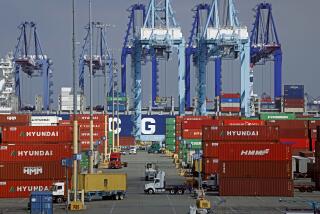Across U.S., the Recovery Is Indeed Uneven
- Share via
In the Golden Triangle of southeastern Texas, where the piney woods give way to erector-set petrochemical complexes, help is definitely wanted. Mobil, Chevron and other big companies are on a building binge and good times are back in the oil patch.
Half a continent away in Connecticut’s Fairfax County, retailers in downtown Stamford are quizzical when asked about the recovery. Business is bad--in jewelry stores, in shoe shops and at the lunch counters--as big employers downsize to cope with the stubborn Northeast slump.
Not so in blue-collar Duluth, the rough-hewn Minnesota manufacturing center on Lake Superior, where things have been up so long that residents no longer talk about down. The shine of the remade Rust Belt glows in its steel mills, shopping centers and bustling port.
These are the snapshots of a U.S. economic recovery that the Federal Reserve Board says “continues to be uneven across the country.” As some areas are still in recession, particularly the Northeast, New England and Southern California, others are enjoying a revival, particularly in the Midwest.
The manufacturing sector is the bright spot. Some of the areas now booming were on the bottom a couple of years ago, as they struggled to retool their aging factories to compete with tough international competitors.
Problems persist nationwide in retail sales, real estate and financial services. Consumers are still wary of the economy’s strength, keeping a lid on spending and further restraining the rebound.
What follows is the economic view, as reported by Times staff writers, from three cities in different regions of the United States.
Duluth, Minn.
As a symbol of this port city’s emergence from the debris of the early 1980s, Richard Baratta, a 33-year millwright, is as meaningful as any. After getting knocked around for 13 years in northeastern Minnesota’s reeling iron ore industry, he fled in 1988 to the new show in town: a $400-million, state-of-the-art paper mill.
The United Steelworker Union member cheerfully joined a non-union shop whose high pay, warm and cuddly “socio-technical” labor-management philosophy and more stable outlook seemed a far better bet for his future than a mining job tied to the steel industry.
“I get tremendously more pay, the working climate is better, the management is better,” Baratta said.
Lake Superior Paper Industries Inc., a joint venture between St. Paul paper company Pentair and Minnesota Power, the local electric utility, operates Duluth’s first paper mill. The company held its own during the nation’s latest recession: There were no layoffs here.
The venture is one of the reasons the 1990-91 downturn looks like child’s play from Duluth’s seasoned perspective.
Duluth, population 85,000, has long depended heavily on Minnesota’s nearby Iron Range, provider of 70% of the taconite ore used to make the nation’s steel. The city’s manufacturing and service businesses continue to depend on iron ore.
Once called “the first rust spot on the Rust Belt,” northeastern Minnesota had been to hell and back by the time the last recession took hold. The region began a slow decline in 1972 with the phase-out of a U.S. Steel Corp. plant. Then 20,000 out of 133,000 jobs abruptly disappeared in 1983-84. Mining jobs tumbled from 15,000 to 6,000 by 1985.
Since 1986, the steel picture has slowly brightened and Duluth has significantly diversified its economy. The result is a less vulnerable economy that saw few layoffs in the recession, save a monthlong furlough of workers at one of the surviving iron ore mines.
“Duluth has really turned the corner in the last five years,” said Dave Foster, Duluth-based director of the seven-state District 33 of the United Steelworkers, whose own collapse in membership here appears to have bottomed out. “The recession was far worse in the Twin Cities (Minneapolis and St. Paul).”
Duluth’s experience was similar to that of some other industrial and manufacturing cities in the Great Lakes region whose enormous job losses and restructurings in the 1980s make them more efficient and tended to insulate them from the latest recession, which has ravaged the the East and West coasts.
“We were less severely impacted because of all the activities that went on at the end of the last recession to get the economy back on track,” said Jerrold Peterson, economist and head of the Bureau of Business and Economic Research at the University of Minnesota-Duluth.
In addition to the paper mill, Duluth’s recovery ingredients include:
* 325 jobs at a frozen pasta plant opened recently by onetime pizza magnate Jeno Paulucci, who in 1982 had pulled 1,200 jobs out of his hometown and moved them to Ohio and later said he felt guilty about it.
* The reopening of taconite plants--one of them non-union--to feed a newly competitive steel industry.
* The growth of Duluth’s medical community into a major regional center that attracted 100 new physicians in one year.
* An invasion of Canadian shoppers unleashed by the U.S.-Canada free trade agreement.
* A surge in exports of Montana low-sulfur coal through Duluth’s big Lake Superior port.
* A tourism-boosting downtown and waterfront face-lift that lends the tough old port city on a hill a certain industrial, seagoing charm.
And when Duluth suffered the loss of a downtown Sears store, the retail building was annexed by the nearby Fond du Lac Indian Reservation. Soon a modest gambling casino opened in a 50-50 venture between the Chippewas and the city. The slots and bingo games just turned the corner on profitability, Mayor John Fedo said, and the two partners could each pocket about $1.3 million next year.
More to Read
Inside the business of entertainment
The Wide Shot brings you news, analysis and insights on everything from streaming wars to production — and what it all means for the future.
You may occasionally receive promotional content from the Los Angeles Times.










